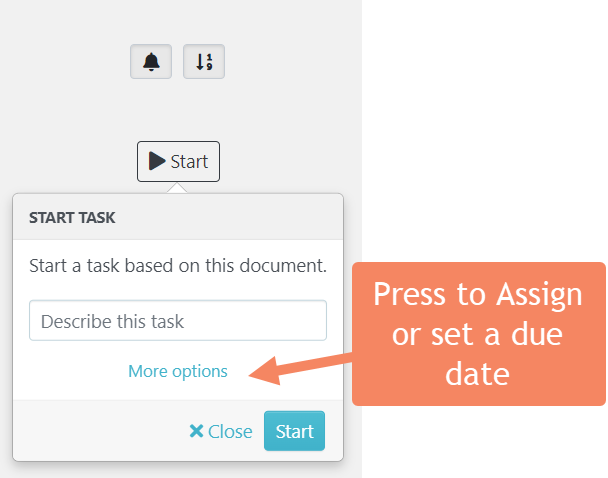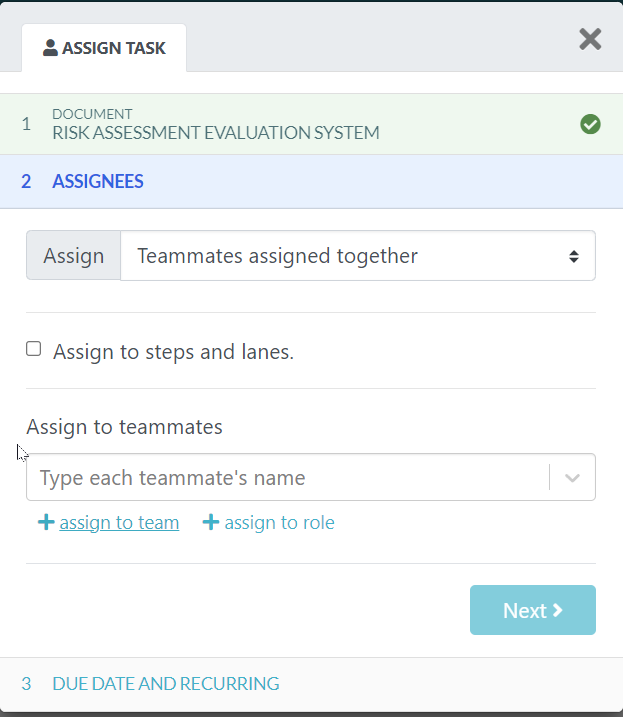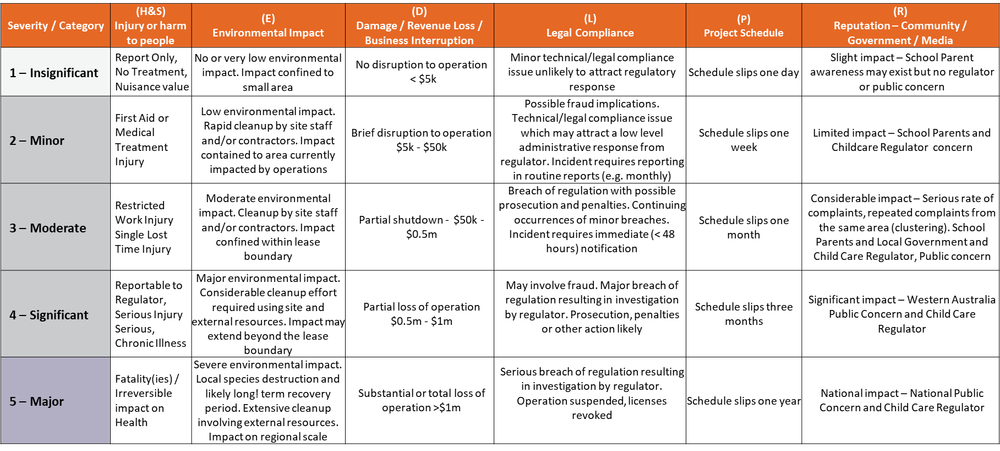Risk Assessment 2024 - Excursion and Transportation Only
Naming Convention
Important: the naming convention for this files should be named accordingly: AKPRS - Assessment Template Task - Activity - Year. For example to undertake Educational Experience at Akidamy like talking hands, the naming of that file is AKPRS - Educational Experience Talking Hands - 2023.

Once you have named the assessment, you can assign to team or individual with a completion date as well by pressing the More Options button.

The following message will appear:

Note that unless the entire assessment is completed, it won't go through the process.

Once you have named the assessment, you can assign to team or individual with a completion date as well by pressing the More Options button.

The following message will appear:

Note that unless the entire assessment is completed, it won't go through the process.
Assessing Risk
Risk assessment is the overall process of risk identification and analysis. It helps us understand our risk profile and the effectiveness of the controls and actions used to manage risks.- Identify the risk
- Assess the risk
- Manage the risk
- Evaluate and manage risk
- Review the risk

Overview
Review the collected information and evaluate the significance of the risk. Consider the following:- What type of hazard
- Activity Identification
- Hazard Identification
- Risk Assessment (No Controls)
- Elimination or Control Measures
- Risk Assessment (With Controls)
- Severity of potential consequences
- Risk Register
- Who Responsible
- When and what data
Definitions of key Activities
Hazard Definitions
Biological- Bodily fluids
- Blood
- faeces, Virus/diesase, vomit or urine
- Discharge from the nose, eyes or ears
- Sewage
- Stinging insects
- Harmful plants
- Animal or bird droppings
- Mould or fungi
- Infectious diseases
- Food
- Food handling
- Preparing food
- Preparing, storing and heating bottles
- Children’s cooking experiences
- Medical
- Allergies
- Anaphylaxis
- Medication dosage
- Non-hazardous chemicals
- Any liquid, solid or gas that does not pose a risk to children
- Eco-friendly dishwashing liquid
- Hazardous chemicals or products
- Any product that has ‘keep out of reach of children’ or first aid instructions on the label
- A lockdown/lockout
- An evacuation – due to fire, flood, structural damage, or other reasons
- An accident – involving anyone at the service
- Any time an emergency service is required to attend the service
- Electricity
- LP Gas (Liquefied petroleum)
- Gas and pressurised containers
- Water systems – water tanks, flooding indoors, lack of water etc.
- Sun exposure
- Water
- Sound and noise
- Animals and insects
- Plants
- Weather conditions and events
- Temperature (hot/cold)
- Extreme Pollution – eg, from bushfire smoke
- Buildings and fixtures
- Driveways, car parks or paths
- Fixed equipment
- Furniture
- Non-fixed equipment
- Play and learning resources
- Cars
- Buses, trains and trams
- Excavator
- Hand tools
- Kitchen Equipment
- Manual handling of equipment
- Lifting children
- Transitions to and from the school or service, between rooms or play spaces
- Social interactions
- Conflict or bullying
- Changes in a child’s family structure eg, the arrival of a new baby or the separation of parents
- Experience of death or other loss
- Inadequate staffing, Parents, and Children
- Visitors and • Guests
- Inconsistent staffing arrangements
- Behaviours displayed by staff, children and families
Likelihood
When thinking about likelihood, the approved provider and service leaders should prioritise actions based on ensuring compliance with the minimum legislative standards, particularly those standards relating to the safety, health and wellbeing of children.Rare
- Very unlikely; the event may occur only in exceptional circumstances. Possibility of occurrence less than 5% - may never occur.
- Unlikely
- Improbable; the event is not likely to occur in normal circumstances. Possibility of occurrence between 5% - 25% - could occur at some time.
- Potential; the event could occur at some time. Possibility of occurrence between 25% - 50% - may occur at some time.
- the event will probably occur in most circumstances. The possibility of occurrence between 50% - 75% - probably will occur at sometime.
- Very likely; the event is expected to occur in most circumstances. Possibility of occurrence of more than 75% expected to occur.
Consequence
This takes into account the potential impact of an event and how it might affect the safety and wellbeing of children, families, staff and the wider community. When analysing the consequences of a potential event occurring, it is important to consider the vulnerability of individuals who might be affected. For example, very young children or children with a disability may be particularly vulnerable as they are less able to act to protect their safety, health and wellbeing.Insignificant:
- no treatment required.
- Minor first aid or minor occupational health safety & welfare liability incident / issue (e.g. minor cuts, bruises, bumps).
- Serious injuries and/or illness.
- Complex welfare and/or healthcare issue.
- Serious disruption or incident, resulting in distress to children and adults.
- Critical incident. (e.g. Death or permanent disability of adult or child; high level of distress to other parties).
- Sustained negative publicity or damage to reputation from a national perspective or from the community welfare perspective
- Multiple injuries requiring specialist medical treatment or hospitalisation; and/or major occupational health safety & welfare liability incident / issue.
- Major incident which damages public or parent confidence.

Risk Matrix

Risk Level Guidelines
Low to Very Low:- Risk Level - If an incident were to occur, there would be little likelihood that an injury would result.
- Action: - Undertake the activity with the existing controls in place (regular planning processes).
- Risk Level - If an incident were to occur, there would be some chance that an injury requiring first aid would result.
- Action - Additional controls may be needed (Document controls in planning documents). Consider obtaining parental or carer permission.
- Risk Level - If an incident were to occur, it would be likely that an injury requiring medical treatment would result.
- Action - Controls will need to be in place before the activity is undertaken. School Director approval prior to conducting this activity is required. Once approved, activity details are to be entered into the Risk Assessment Register. Parental/Carer permission must be obtained for children's participation.
- Risk Level - If an incident were to occur, it would be likely that a permanent, debilitating injury or death would result.
- Action - Consider alternatives to doing the activity. Significant control measures will need to be implemented to ensure safety. School Director and Approved Provider approval prior to conducting this activity is required. Once approved, activity details are to be entered into the Risk Assessment Register. Parental/Carer permission must be obtained for student participation.
Elimination Controls
Level 1 - Elimination & Substitution (Most effective control measure)- Remove the hazard - Broken toy or damaged resources to be disposed of
- Change the practice - Request food delivery to be taken directly to the kitchen to eliminate manual handling of bulky deliveries to the kitchen by educators
- Separate unwell children from others
- Barricade off a wet floor until dry to avoid slipping hazards, display a ‘wet floor’ sign
- Use ergonomic cots with a higher base height to reduce manual handling and back injuries for educators
- Provide adult-sized chairs for educators
- Rotate educators between different tasks to avoid repetitive strain
- Arrange workflows to avoid peak physical and mental demands towards the end of a shift
- Use gloves while changing a nappy or when cleaning bodily fluids
- Wear closed-in shoes to avoid injury
- Wear hats and sunscreen outside
Inherent Risk Levels
Please do not engage in this activity under any circumstances that would reduce the risk to medium or below. The School will not undertake any critical or high-inherent-risk Inherent Risk Activity.
Commination
Ensure the approved risk drafting sheet is communicated to the relevant individuals or teams.
This may include:
- Sharing the document through appropriate channels
- Providing training or instructions on how to interpret the risk sheet
- Making the risk information accessible to those who need it
-
1Risk Assessment Application & DetailsBackground Information
-
2Excursion and Transport (Information)
Collect all relevant information related to the risk that needs to be documented.
This includes:
- General Overview Activities / Details / Excursion Details / Experience
- Classification of Event
- Rationale and links to children’s outcomes – What value does this experience have for the child(ren)’s learning and development?
- Which studios will be participating?
-
3Analyze and assess the risk
-
4Activity APlease keep in mind that the answer type form is in point form.
-
5Activity BPlease keep in mind that the answer type form is in point form.
-
6Activity CPlease keep in mind that the answer type form is in point form.
-
7Activity DPlease keep in mind that the answer type form is in point form.
-
8Activity EPlease keep in mind that the answer type form is in point form.
-
9What is the Highest Risk Score from all based on detailed risk Assessment after Mitigation and Controls?

This is a critical step, and you must ensure that it is completed correctly or the assessment will not be approved. -
10Not Approved
-
11End - Not ApprovedRedo the plan with you supervisor to reduce the inherent risk
-
12Approve Provider Approval the PlanDo you approval the plan.
If no then the plan will need to redone which inherent risk reduce -
13Detailed Review or Approval
-
14End - ApprovedPlan approved an Completed
Did this answer your question?
If you still have a question, we’re here to help. Contact us

